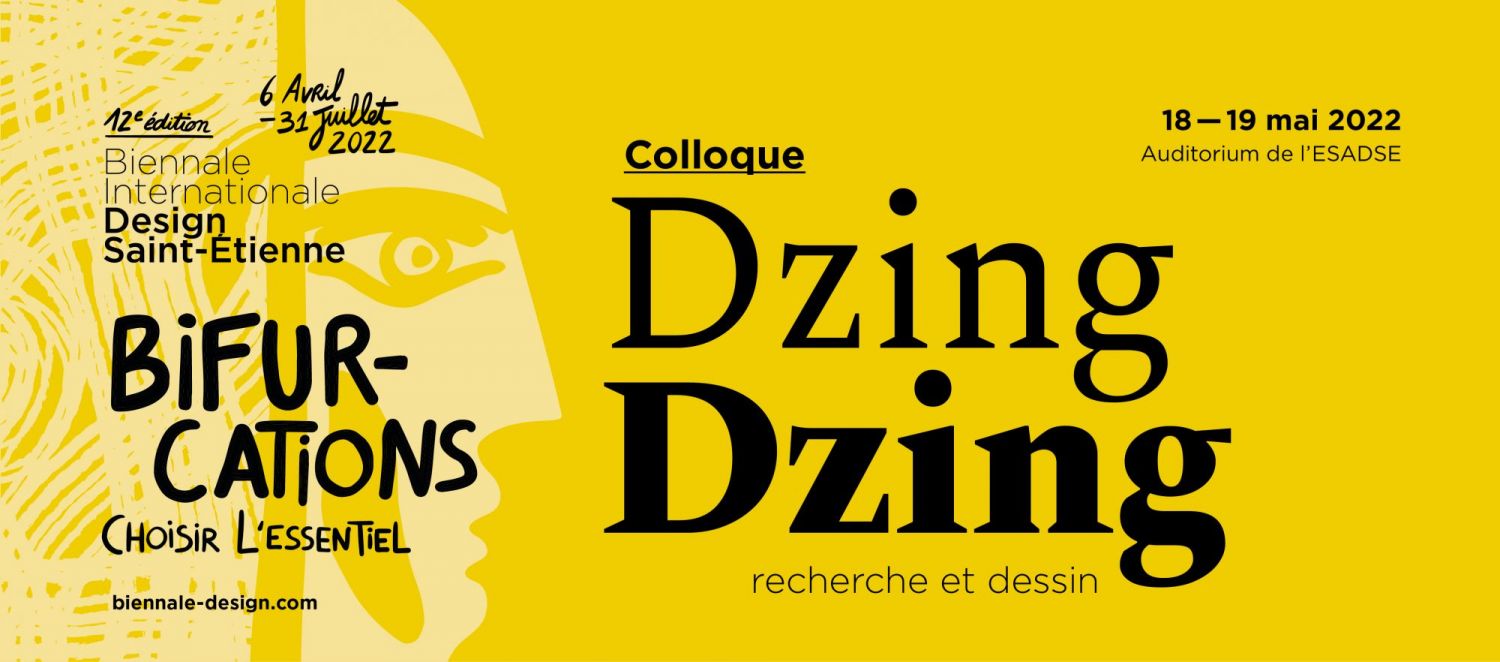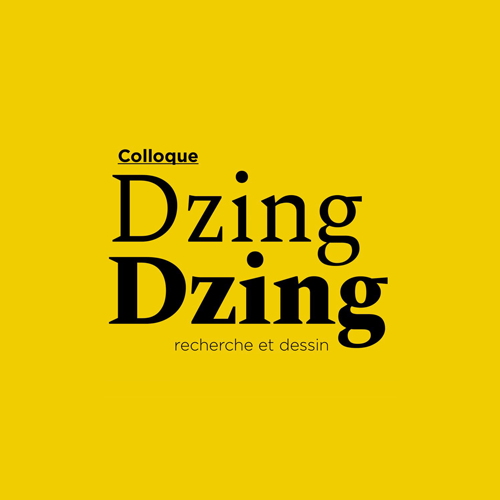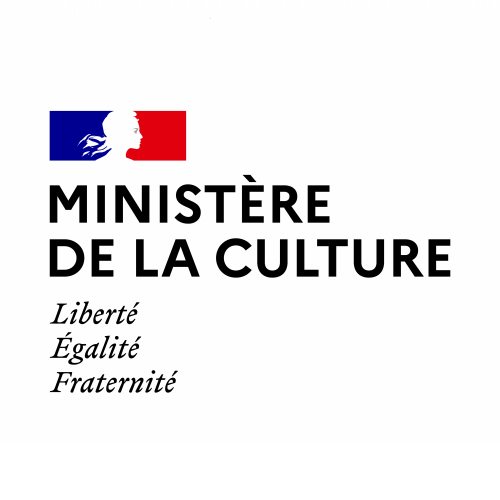
Registration is free but mandatory:
In person attendance and/or webinar
13.00 – Arrival of participants
14.00– 14.20
Conference opening
Éric Jourdan, Director of ESADSE (Saint-Étienne Higher School of Art and Design)
François Quintin, Visual Arts delegate, Directorate General for Artistic Creation, Ministry of Culture
Denis Declerck, Subdirector in charge of specialist and higher education and research, Directorate General for Artistic Creation, Ministry of Culture
14.20– 15.00
Introduction
Presentation of the day's programme and positioning of the theme by Olivier Peyricot
Orientations and questioning of the links that tie drawing to design research.
Olivier Peyricot, designer, Director of the Research department at the Cité du Design, Saint-Étienne.Curator of the 10th Biennale Internationale Design Saint-Étienne 2017 Working promesse, les mutations du travail, Scientific Director of the 12th Biennale Internationale Design Saint-Étienne 2022 Bifurcations, curator of several exhibitions: Née dans les fougères 2015, Panorama des mutations du travail 2017, Dépliages 2019,Autofiction 2022.
Video Interview with Claude Imbert
Putting the theme into perspective with Claude Imbert: an interview with Claire Brunet
Claude Imbert is a French philosopher and logician. Translator of Gottlob Frege, she is an Emeritus professor at the École Normale Supérieure.
15.00 – 16.00
Round table 1: Production drawing
Patrick Beaucé, Laure Brayer, Jürg Lehni, Adrien Vasquez, Gilles Rouffineau (moderators)
Design as a production process uses a palette of tools, some of which are designed in turn to respond to the fluctuations in production modes. Whether we are taking about drawing software packages that enable the process to be anchored under the aegis of a generic and multiple pixellisation and vectorisation of a project, from the initial phase (sketching) to the production phase('industrialisation'), a digital common applies to the entire process. This process raises questions for designers and researchers regarding its linearity: what does it tell us about our dependency on the machine and its software? What are its weaknesses ? What modes of "bifurcation" are necessary to arrive at the creative project ? Another input linked to the production process: work in a'production line', from the client to those executing the orders and taking in the various subcontractors, all within a constrained timeframe. Drawing here appears as an object of design and mediation, contracted out to a third party : author but also machine, an automatic reproduction machine, etc. The modes of interpretation, the entanglements between singular writing and collective execution of collaboration at work in drawing. It seems there are only drawings done by several hands. The project as a composite entity.
Patrick Beaucé is a designer and professor at ENSAD Nancy (Higher National School of Art and Design). In the field of architecture and design, he has worked on the development and application of advanced concepts (parameterisation, associativity, etc.) from computer-assisted drawing and manufacturing(CAD/CAM). With Bernard Cache he founded the architecture and agency and production workshop Objectile Production (1995–2011). He leads several research projects, all of them closely linked to pedagogy and education as well as to their territorial contexts, at DM-lab, the environmental design laboratory at ENSAD Nancy.
Laure Brayer is an architect and holder of a doctorate in architecture. She teaches Arts and Techniques of Representation at ENSAG and is a researcher at the AAU-CRESSON laboratory (UMR (mixed research unit) on Ambiences, Architectures, Urbanisation). Her research focuses on sensitive experiences of contemporary spatial transformations and their multiple representations. Based on in situ surveys of inhabitants, her work consists of making intermediate graphic objects (sensitivity maps, transects, films, exhibitions,etc.) enabling the story of a place to pieced together and practices and projections debated. It thus questions the articulation between mediation, criticism and project.
Jürg Lehni (born in Lucerne in 1978, lives and works in London and Zurich) is a freelance designer, artist and developer. With exhibitions all over the world, Jürg Lehni creates production and research platforms and scenarios. He works on and orchestrates the potential of the digital, the analogue and the technical. His work therefore ties in neatly with a reflection on the internet, software and the media mix, highlighting their artistic potential. He reinvents usages with and through programming, creating new spaces and new modalities for drawing.
Adrien Vasquez (livesand works in London) is a graphic designer and typeface designer. Since 2011, he has been working with John Morgan, with whom he co-founded a type foundry, Abyme, in 2017 to distribute their typefaces and work on editions of objects and multiples in collaboration with artists and designers. A graduate of ESAD Valence, today he teaches type design there. In practice research and the response to an commission are closely linked. The richness of his interventionslies in the transversality of his places and modes of expression as much as it does in the variety of the iconography called upon.
Gilles Rouffineau, a photographer by training, teaches on the graphic design course at ESAD-GV (Higher School of Art and Design of Grenoble and Valence). An associate researcher in the 7472 Practices and Theories of Contemporary Art research group at the University of Rennes 2, he is involved in several lines of research (Art and Programming, Low Def., Issues in graphic design) with ESAD Valence, where he co-directs a research unit named "There is no knowledge without transmission" with Annick Lantenois. His publications cover photography, graphic design and digital publishing (Éditions off-line,Projet critique de publications numériques, 1989-2001, Paris,B42, 2018)
16.00 –16.30
Esquisse 1
Baptiste Meyniel: Tools for drawing/design
Samantha Zannoni: Visual sound converter
Charlotte Goffette: Using drawing as an anchor
Baptiste Meyniel is a graduate of ENSCI-Les Ateliers en création industrielle (2017), the École Normale Supérieure Paris-Saclay and holder of the agrégation in design(2015). During his diploma project at ENSCI Baptiste developed an empirical approach by questioning in turn the moving of the gaze, the process of forming with tools, what the material outlines and what we project into the material. From this process, and closely tied in with movement and gesture, three propositions would emerge: drawing tools, free forms and lamps. Today, he is continuing his research on the SACRe doctoral programme at the EnsadLab, articulating his reflections around the issue of automatic reflexes within the creative process in design. Baptiste is currently completing a research residency at the CIRVA (International Centre for Research in Glass and the Plastic Arts) after winning a call for projects put out by the institution in 2019."
Samantha Zannoni is currently a first-year DSRD (higher diploma in Design Research) student at ESADSE; In 2021 she passed her DNSEP (postgraduate diploma in Plastic Arts) (graphic design) at ESAD-GV (Valence site). Her practice covers codes, drawing and publications in digital or paper form. She is co-editor of the StockoZine project, a collaborative, participatory fanzine. Her dissertation entitled "Writing drawing" enabled her to get to know many people involved in programmed drawing and to enrich her personal practices around the issue of drawing and code, two notions that are now the driving forces behind her work.
Charlotte Goffette is a young Belgian artist-designer, a graduate of ESADSE and ESAD Orléans. Her work, which oscillates between research and narrative, question the way we cohabit with other life forms. In 2020, her Cité d’Avel project led her to join the 3rd Cycle at ESADSE. In 2022, she is in residence at the Ateliers Médicis. In addition, for the Biennale Internationale Design Saint-Étienne 2022, she has developed Les Anémois, a bench that features the Saint-Étienne wind rose.
16.30 – Break
16.40– 17.40
Round table 2: The death of drawing & counter-practices ? Radicals & speculatives…
James Auger (video), David Bencque, Nathalie Bruyère, Claire Brunet (moderators)
We are well aware of the appetite for speculative design or rather critical design, as it was practised at its beginnings (between 1995 and 2000), for radical Italian design. From the Superstudio scenarios to Sottsass's scripted video at MoMA (1972) to the images and "products" of design fiction where does the reality of drawing, and its uses, lie ? Why in one case does it seem to be a project ? And why in the other case, does it seem to disappear, when a conference like the Bartlett UCLDrawings Futures conference (Nov. 2016) seems to demonstrate its relevance or necessity ? Does drawing as part of a project that deals with utopia, dystopia or uchronia and drawing as it was practised by the counter-cultures ofthe 60s and 70s 70 tell us anything about the genealogy that links radical design and its paper design methodologies (from about 1965/68) to the emergence of the initial thinking, in the 2000s, of Anthony Dunne (1999), who seems to be proposing the disappearance of drawing? It is this paradox that will be presented and discussed.
James Auger is a designer, Director of the Design departmentat ENS Paris-Saclay and Co-Director of the CRD. He co-edited (with I. Mitrovic, J. Hanna and I. Helgasson) the recently published Beyond Speculative Design :Past-Present-Future, Split: SpeculativeEdu, University of Split
David Bencqué is a designer and associate lecturer at Goldsmiths (University of London). He was a Bio Model Analyser at Microsoft Research in Cambridge (2010-2015) and visiting lecturer in Interactions Department of the Royal College of Art (2010-2015). His thesis (2020) is entitled "Case Boards, Traces & Chicanes. Diagrams for an archaeology of algorithmic prediction trough critical design practice".
Nathalie Bruyère founded POOL Products with Lorenz Wiegand in 1998 after completing her training at the Domus Academy in 1994, and then Design & Architecture agency Duffau &Associes. The agency combines its work with research through an association, Ultra Ordinaire. The objective is to explore production through new technologies and manufacturing tools for projects situated in specific environments, through open standards. At isdaT, she is in charge of research on Global Tools. A book on this work is due to come out in 2022, in collaboration with philosopher Victor Petit.
Claire Brunet is a philosopher and researcher at the Centre for research in design (ENS Paris Saclay/ENSCI-Les Ateliers) specialising in the history of design. Recent publications: editing with Elie During of the "Archi-Design" design issue of Critique (September 2021) and "Une anatomie réelle. Germania de HansHaacke (Pavillon allemand,Biennale de Venise 1993)" in D. Bihannic, B.Gabillon, O. Koettlitz, J. Le Creurer, A. Maillard (ed.) Empavillonrer, ((Athom,2021).
17.40 –18.00
Esquisse 2
EddyTerki: Drawing as testimony
Rose Dumesny: An ABC of movement
Armelle Antier: Drawing has taken
Eddy Terki is a graphic and spatial designer based in Saint-Ouen and Saint-Denis. His work revolves around questions linked to the identity of a territory, the inhabitants, languages and education (teaching tools). His graphic projects combine movement, the gestures of writing and space. Over the years, Eddy has developed an approach that leads him to create through different types of interventions, from residencies to graphic commissions. All of which taken together constitutes a contextualised body of work anchored in situated territories.
Rose Dumesny has a PhD in Information and Communication Sciences, special subject design and interaction designer. After graduating in product design at ENSAAMA, she then completed a thesis at the University of Nîmes and Orange Labs. Her research work concerns the way design can create mediations sensitive to the digital, allowing each person to appropriate and understand complex systems. She is now working in a team of researchers at frog design on the impacts of AI in particular.
Armelle Antier is an interior architect and designer, a graduate of the École des Arts Décoratifs de Paris. Her diploma project was entitled "I'd be happy with a world where architects don't build any more" and questioned the role of the architect,proposing alternative modes of action to construction/deconstruction/destruction. Through a study and relevé habité-type survey of multi-dwelling housing, she proposes a softer; more progressive mode of investigation than the works usually undertaken to improve inhabitants'quality of life.
18.00 – 18.20
Conclusionwith Guest Speaker
Sophie Pène is the curator of the Le Monde Sinon Rien (The World or Nothing) exhibition (Biennale du design de Saint-Étienne 2022), which is dedicated to transformations happening in design schools under the impetus of the students, who are lucid in their perception of social and ecological change. A professor of Information and Communication Sciences at the University of Paris (2005-2021), she is a member of the French National Design Council (CND) (2021-2023). She was a member and Vice-President of the French Digital Council (CNNum) (2013-2017), the Fabrique de l’industrie and the Scientific Council of the Institut Mines Telecom.
18.30-22.00
Launch of Problemata
The digital platform for researchers and students
Espace BifurquantRegistration is free but mandatory
This conference is co-organised by the Ministry of Culture and the12th Biennale Internationale Design Saint-Étienne













